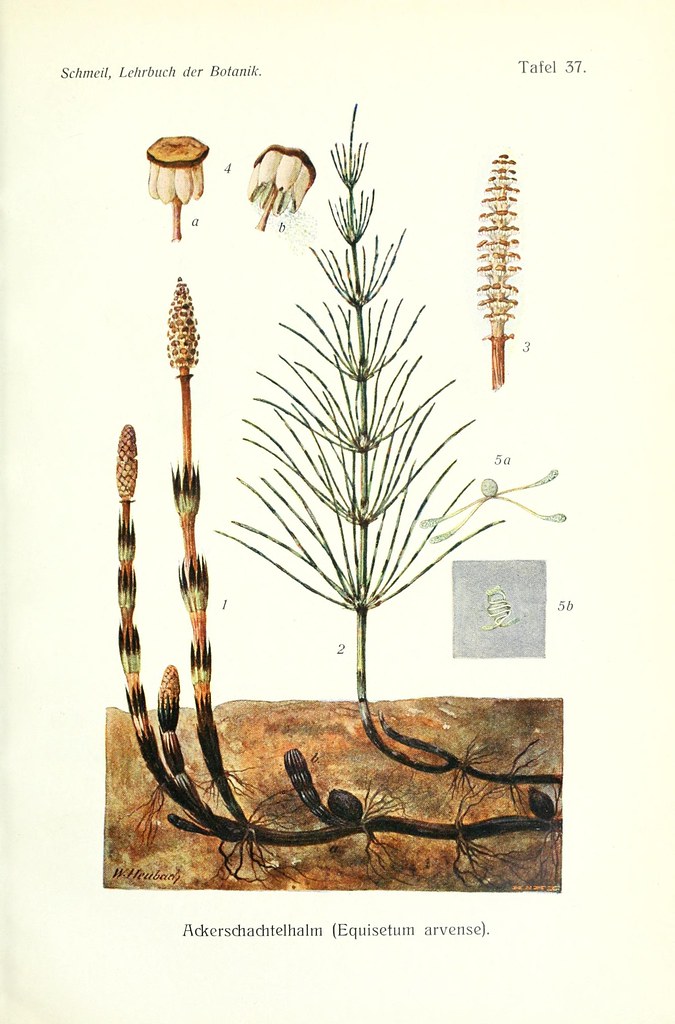#Equisetum arvense
Text

i really love that they're canonically friends
#touhou#touhou project#rin kaenbyou#orin#orin touhou#chen#chen touhou#unnamed corpse#own art#Plantago hakusanensis#Acer japonicum#Equisetum arvense#Parthenocissus tricuspidata#Setaria viridis#unidentified dandelion#sorry i just sorta thought dandelion in general not a specific one#lots of unidentified grass too
171 notes
·
View notes
Text

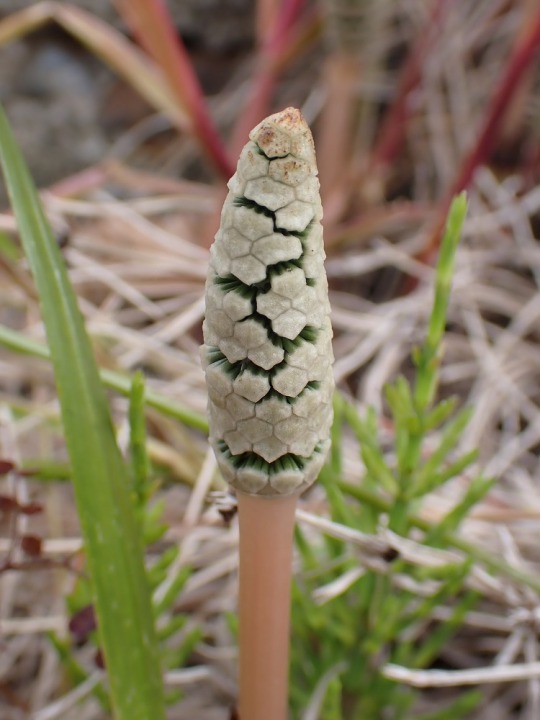
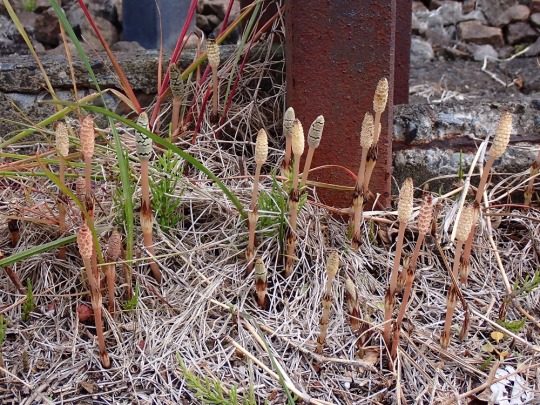
線路沿いにツクシが出てき���。六角形の若い胞子嚢が好ましい(3月7日)
Skrzyp polny (Equisetum arvense)
field horsetail or common horsetail (Equisetum arvense)
25 notes
·
View notes
Text
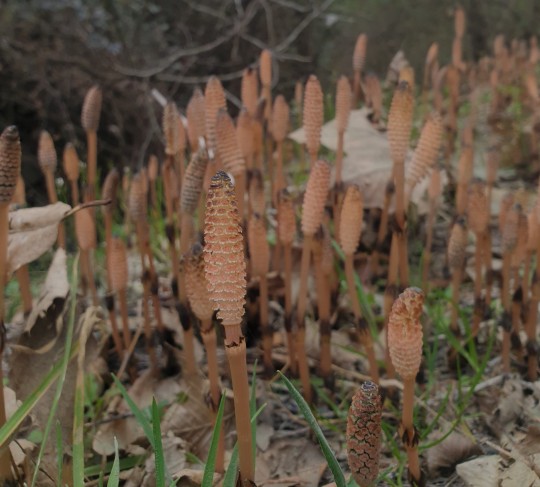
strange planet
4 notes
·
View notes
Text
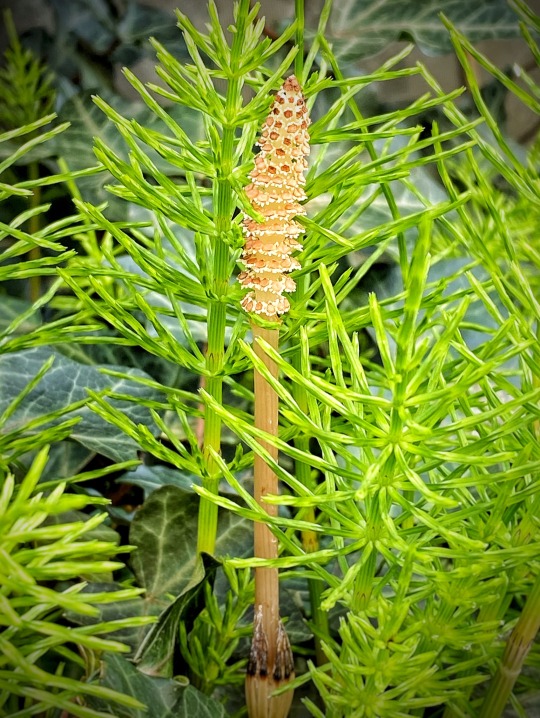
仕事に向かう途中のブロック塀の上にあった、
「ツクシ(土筆)」とスギナ。
別名:ジゴクグサ(地獄草)、ミモチスギナ。
欧文名:Equisetum arvense
4 notes
·
View notes
Video
n452_w1150 by Biodiversity Heritage Library
Via Flickr:
Lehrbuch der Botanik;. LeipzigQuelle & Meyer1911. biodiversitylibrary.org/page/22538212
#Botany#Gerstein - University of Toronto (archive.org)#bhl:page=22538212#dc:identifier=http://biodiversitylibrary.org/page/22538212#Equisetum#University of Toronto - Gerstein Science Information Centre#Equisetum arvense#field horsetail#common horsetail#botanical illustration#scientific illustration
1 note
·
View note
Text

#alyssum#sedum#vinca#calendula#episetum#begonia#dalia#garden#jardin#bunny#conejo#cola de caballo#equisetum arvense
0 notes
Text
HSN Beauty Formula - Farmasi USA
https://farmasius.com/ua000007/product/detail/hsn-beauty-formula?pid=1000905
HSN Beauty Formula support and maintain the growth of healthy hair, skin and nails with unique combination of Zinc, Biotin, Argan Extract, Hyaluronic Acid, Type I Collagen and other valuable components.
It is also:
NON GMO
GLUTEN FREE
LACTOSE FREE
NO PRESERVATIVES
NO SWEETENER
NO ADDED COLOR
NO ADDED…

View On WordPress
#Alpha lipoic acid#Argan extract (Argania spinosa (L.) Skeels#Calcium d-pantothenate#Cholecalciferol#Choline bitartrate#D-Biotin#Dl- alpha tocopheryl acetate#Emulsifier: Magnesium stearate#FARMASI Colombia#farmasi usa#Ferrous fumarate#Green tea extract (Camellia sinensis#Herb#Horsetail extract (Equisetum arvense#hyaluronic acid#Hydrolyzed Collagen#L-Ascorbic Acid#Leaf)#Manganese sulfate#Methylcobalamin#Microcrystalline Cellulose#Nicotinamide#Para-amino benzoic acid#Pteroylmonoglutamic acid#Pyridoxine hydrochloride#Retinyl Palmitate#Ribo_avin#Seed oil)#Sodium selenite#Thiamine mononitrate
0 notes
Text

horsetails..equisetum arvense..
144 notes
·
View notes
Text
herbal teas guide —
🌿🍃 having conversations with my mutuals all over the world, i was stunned to find out that not every country/culture practices drinking herbal teas for health issues. as a slavic person i decided to create this little guide because – and i'm saying this as a skeptical person who hates superstitions – they really work. 🌿🍃
mint tea (mentha piperita) is for digestion and relaxation
chamomile tea (matricaria chamomilla) is for digestive system
horsetail tea (equisetum arvense) is for skin, hair, nails condition, remineralization and circulatory system
linden tea (tilia cordata) is for a cold
lemon balm tea (melissa officinalis) is for relaxation and sleep
nettle tea (uritca dioica) is for urinary tract
sage tea (salvia officinalis) is for when your throat or teeth hurt
fennel tea (funiculum vulgare) is for digestive system
white mulberry tea (morus alba) is for carbohydrate metabolism
pansy tea (viola tricolor) is for clean skin and body detox
purge tea (cistus incanus) is for immunity
hawthorn tea (crataegus monogyna) is for heart and circulatory system
damian leaves tea (turnera diffusa) is for anxiety and libido
dandelion tea (taraxacum officinale) is for liver, stomach and digestion
st john's wort tea (hypericum perforatum) is for emotional balance, good mood, digestive system and kidney function
🌿🍃 to create this guide i was using a booklet from my pharmacy store. if you google them, you will find out that each of these have even more usage methods than the ones listed. 🍃🌿
🌿🍃 if you're from a different country/culture and you know more herbal teas like these, feel free to add them. 🍃🌿
#felt extra this evening but ive been planning to make it for a few weeks now#posted by me#slavic#polish#poland#herbs#herbal#organic#health and wellness#tea#guide
138 notes
·
View notes
Text
the harveston sledathon event: jade leech's "incantation"
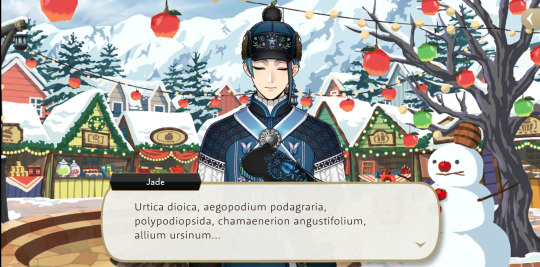

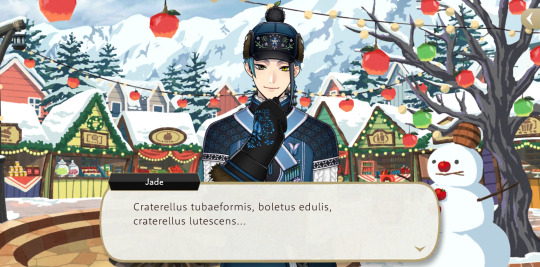
i'm not sure if everyone has gotten to this part in the new english server event yet, but this part when they were at the market got me curious. so, in typical me fashion, i committed a day of research to figure out what the hell jade was talking about.
first i would like to say that this was put together with A DAYS WORTH OF RESEARCH so if you know more about these plants/mushrooms and would like to add information or correct me please do so in the replies!! i'm not an expert by any means LMAO
with that said, onto the first plant!! i will list the scientific name that jade uses first and then the common name in parentheses. each plant/mushroom will have a picture after the short description for reference!!
i got all these images from google obv
~~~~~
Urtica dioica (Stinging Nettle) - A perennial herb that grows best in moist areas. Grows in late fall to early spring. Fall sun, partial shade. Used as an herbal remedy for sore muscles and seasonal allergies.

Aegopodium podagraria (Ground Elder) - Marked as an invasive species in some of the eastern states of the US (Pennsylvania, Connecticut, New Jersey, Vermont, Michigan, and Wiscousin.) Thrives in moist soil and grows during the summer. It’s commonly used in soup and as a remedy for gouts.

Polypodiopsida (Ferns!!!) - Thrives in moist soil and grows near rivers and creeks. Grows in shady locations in early spring. They reproduce with spores. Fiddlehead ferns are the curled up fronds of a young fern that can be cooked and eaten in various ways (steamed, fried & stored, roasted, pickled, etc.) They can also be used as fertilizer and for landscaping.
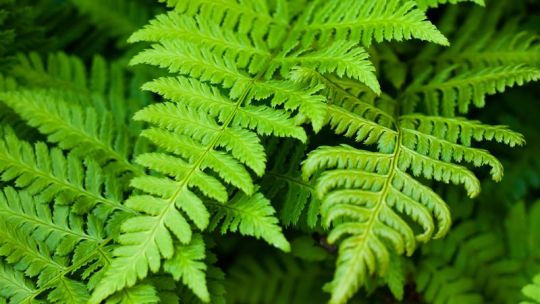
Chamaenerion angustifolium (Fireweed) - A perennial herb that flowers in June to September. Grows in full sun to partial shade and moist, well drained soil. Its primary use is medicine but it’s also used in tea, which in turn can be used to treat migraines, infections, and colds. Young fireweed shoots can be cooked and eaten (apparently, they taste like asparagus and should be cooked like them, too.)
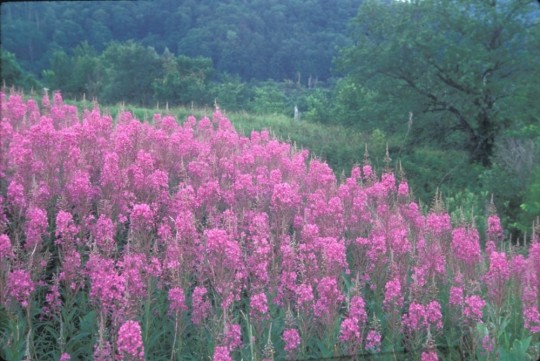
Allium ursinum (Wild Garlic or Cowleek) - Thrives in slightly acidic soil & moist conditions. Prefers shady conditions and grows around winter to spring, with a peak season of February to April. You can eat basically the whole plant, but if you eat the bulb the plant obviously won’t grow back. It’s been used as a medical plant and in cooking.
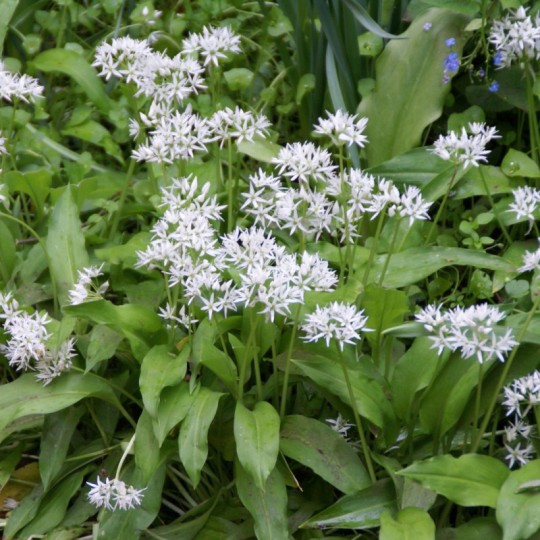
Sorbus (Mountain Ash or Rowan) - A bush that produces edible berries in late summer into early fall, and they stay on the tree into winter. The berries should not be eaten raw, but should be cooked because they contain parasorbic acid. The cooking process converts the parasorbic acid into a preservative sorbic acid. Their astringent taste is made sweeter by the frost. They grow best in full sun to partial shade and moist, well drained soil. They usually grow up to 15 meters tall.

Plantago major (Broadleaf Plantain) - A perennial herb that grows in late spring to summer (and sometimes in autumn.) They prefer moist soil but are very adaptable. Grows in moderate shade to full sun. The entire plant is edible, but apparently the flower shoots are especially delicious. They naturally grow in very dense populations and are easy to harvest. Works as a medicinal herb to treat inflammation and boost the immune system.

Equisetum arvense (Field horsetail) - Another perennial herb that grows from summer to the first frost. Grows in moist soil with full to partial sun. Can be used in tea and benefits the urinary system. Their root systems can grow as deep as six feet.

Craterellus tubaeformis (Winter mushroom, or funnel chanterelle) - Our first mushroom!! They are featured in a lot of recipes and are fairly common. They’re ready to harvest in mid-winter to mid-spring. They can be found in mossy areas with well decayed wood, and grow in loose clusters. They apparently have an earthy/fruity taste, and should be cooked so they don’t taste unbearably peppery.

Boletus edulis (Penny Bun) - Another mushroom with a dark brown cap. Spores grow more mushrooms in summer and autumn. Thrives in moist soil and can be harvested a few days after summer rain. They’re around 25cm tall on average and can weigh a kilo (which made me yell out loud, mind you. That's a big mushroom!!) They have a slightly nutty flavor.

Craterellus lutescens (Yellow Foot) - The last item on this list is another mushroom. It thrives in moist soil and they grow from 2-7 cm in length. They apparently have a peppery flavor when raw, but taste earthy when cooked. They typically grow around moss in loose clusters. They’re pretty similar to the craterellus tubaeformis, as one would expect from their shared genus, “craterellus.”

~~~~~
Overall Plant Conditions (AKA patterns I noticed while researching):
Practically all of these plants love moist & well drained soil. A lot of these plants grow in the summertime and like full/partial sun, but there’s a few exceptions of course. There’s a lot of herbs and perennial greenery that have medicinal properties. Many plants on this list grow well in disturbed soil or near water and roadways. All of them are edible (but beware of dangerous lookalikes!)
anyways < jade leech 3 i hope you found this somewhat interesting because i sure did!! (which is why i spent all my free time today researching it sigh the things i do for mermen)
#auburn's rambles <3#gonna make that a tag#jade leech#twst jade leech#disney twisted wonderland#twisted wonderland#disney twst#the harveston sledathon#auburn's fungi time <3
180 notes
·
View notes
Text
Dead Wood Isn't Dead Weight in Habitat Restoration
I've been slowly rewilding my yard; almost every plant growing in it when I moved in was non-native, from purple foxglove (Digitalis purpurea) to sheep sorrel (Rumex acetosella) to at least four species of non-native grasses. The natives were sparse, mostly limited to beach strawberries (Fragaria chiloensis), trailing blackberry (Rubus ursinus), and field horsetail (Equisetum arvense), along with a few native shrubs like salmonberry (Rubus spectabilis) and twinberry honeysuckle (Lonicera involucrata).
A lot of what I've been doing is removing non-native species while introducing native ones. It's been an uphill struggle since the non-natives are largely species that have evolved to quickly colonize disturbed land and out-compete most of the natives, which has meant a LOT of weeding. In some cases when I've had to open up entire areas of the yard that will have heavy foot traffic, I've had to sow various clovers as a quick solution to keep the other non-natives from crowding their way in. Clover, at least, is easier to remove, and once I have a chance to kill it it will release the nitrogen it has collected into the soil, making it a better spot for whatever I plant there next.
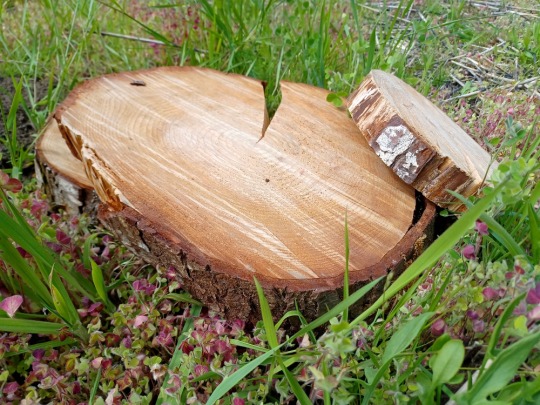
This morning before I started work I decided to get just a little more gardening in. I had these three log slices I was given a while back; the largest is over a foot in diameter. I decided to use them to create a small woody debris pile in one part of the yard that was rather sparse on such things. It's nothing too fancy; they're simply leaning on each other to create a little space underneath.
But these are important additions to this habitat in progress. Lots of living beings rely on dead wood for food or shelter--or both. While these wood slices look pristine now, it's likely that in the next few years they'll collect an array of inhabitants, from lichens and moss to insects and bacteria. Some of these will simply take up residence in the shelter I've created; others will do their part as decomposers and break down the cellulose and lignin in the wood. Eventually, if left in place, the slices will eventually return to the soil, adding to the nutrient load being passed around from being to being in this ecosystem.
Most often when woody debris is mentioned in habitat restoration, the focus is on large example like entire snags, nurse stumps, and nurse logs, or on dead trees piled up in rivers and streams. These are, of course, important examples thereof. However, many people don't have the space for an entire dead tree in their yard. In that case, smaller installations are perfectly reasonable and will still create habitat for your local wildlife like insects and other arthropods, snakes, toads, etc.

I also took the opportunity to take a quick peek at a stack of red alder (Alnus rubra) logs I had set up a couple of years ago. They'd already brought their own patches of moss, but the wet weather and resident decomposers have been doing their work, and the bark is beginning to slough off of some of them.

The previous owner of this property did some landscaping with dead wood; this is probably the largest, an old log about five feet long that I think looks a bit like an alligator's head. As you can see, it's pretty weathered at this point; the old knot has rotted out and the remaining wood has numerous cracks and splits, and the bark has long since decayed.
I'm going to keep adding small wood piles around the yard as I'm able to make space for them. They do need to be worked around when I'm attending to live plants, and can be an obstacle to mowers and other tools. I want to not have to disturb these little habitats once they're established, so I'll be adding them in deliberately. This sort of planning is important if you're going to be creating woody debris piles in your yard as well, so that your local wildlife are free to set up their homes without worrying about sudden eviction. If you're in an area with venomous snakes, or if you're concerned about termites or carpenter ants using a wood pile to hopscotch over to the wood in your home, you may want to make sure you create habitat further away from the house and other buildings. Finally, make sure that no one uses these piles as jungle gyms; the animals living inside them can be easily crushed if the wood is shifted around or compressed.
Did you enjoy this post? Consider taking one of my online foraging and natural history classes, checking out my other articles, or picking up a paperback or ebook I’ve written! You can even buy me a coffee here!
#habitat restoration#ecology#nature#wildlife#animals#plants#fungi#science#scicomm#gardening#garden#outdoors#environment#environmentalism#conservation#long post#rewilding
294 notes
·
View notes
Text
my garden is overgrowing with these and i was just going to compost them and make antifungal juice to spray on other plants but maybe not. some of these results look really fun

that's a beautiful yellow!
#plants#2make#kind of annoying to look at. the 2watch/2make/2read tags that is. but i'm not about to go back and change it
4 notes
·
View notes
Text

【庭】スギナが出てきた。葉の先端に水滴がついている。五重塔みたい(2月26日)
Skrzyp polny (Equisetum arvense)
field horsetail or common horsetail (Equisetum arvense)
14 notes
·
View notes
Text
Karelian words - Medicinal plants
Rohtuheiny - herb, medicine
Rohtuheinät - medicinal plants
Ailasheiny - Geranium sylvaticum
Anistuheiny - Pimpinella anisum
Akanheiny - Hierochloë hirta esp. subsp. arctica and praetermissa
Ambujaiskukka, hevonboba - Knautia arvensis
Butkiheinä, ičenbutki - Angelica sylvestris
Čosnokku, valgolaukku - Allium sativum
Dorogaheiny - Plantago major
Horma - Chamerion angustifolium
Huuhky, suurikaza - Heracleum, esp. sibiricum and sphondylium
Heracleum sosnowskyi is widely spread in Republic of Karelia and is non-native species that is harmful for native flora.
Härkiheiny - Equisetum arvense
Kadai - Juniperus communis
Kadaimarju - cones of Juniperus communis
Kalaheiny - Mentha, esp. Mentha aquatica
Kirkiheiny - Drosera rotundifolia
Kulkkuheiny, čäijyheiny - Hypericum esp. maculatum and perforatum
Kumino, pikkukaza - Carum carvi
Naizienpaganaheiny - Drosera longifolia
Laukkuheiny - Allium schoenoprasum
Oravanheiny - Athyrium filix-femina
Porstutheiny - Geranium pratense
Suokannarvo - Rhododendron tomentosum
It's important to notice and understand that medicinal herbs and spices have large overlap and are referred with same general name. Karelians view food as medicine and medicine as food, which is reflected in this overlap.
DO NOT use this list as medicinal guide! Never consume plants or berries you do not recognize and know the use of.
Make sure that the plants you plan to pick are not protected vulnerable species and harvest even common plants only if you know appropriate ways to show respect and gratefulness.
8 notes
·
View notes
Text
Ranogrin → Horsetail
I spent a good amount of time trying to figure out what this could be. It looks kinda like a small evergreen shrub/the harvested version looks like a pine bough, but when you pick the plant in-game it looks like multiple plants, not just one shrub. Eventually ended up going through a photo album of native Polish plants and decided that the game version looks a lot like horsetail (specifically Equisetum arvense).
In the Polish books, it’s called “ra-nog” and in the english translation it’s “scarix” (could they be thinking about carex/sedges?).
“The modest yellow-gray brushes peering from chests deeply sunken into the ground revealed scarix, a root with powerful and universal medicinal qualities.” (The Voice of Reason 6).
The only sedge/carex I can find with medicinal properties is sand sedge.
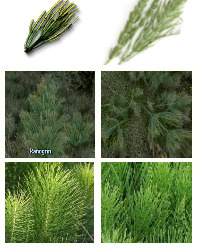
2 notes
·
View notes
Text
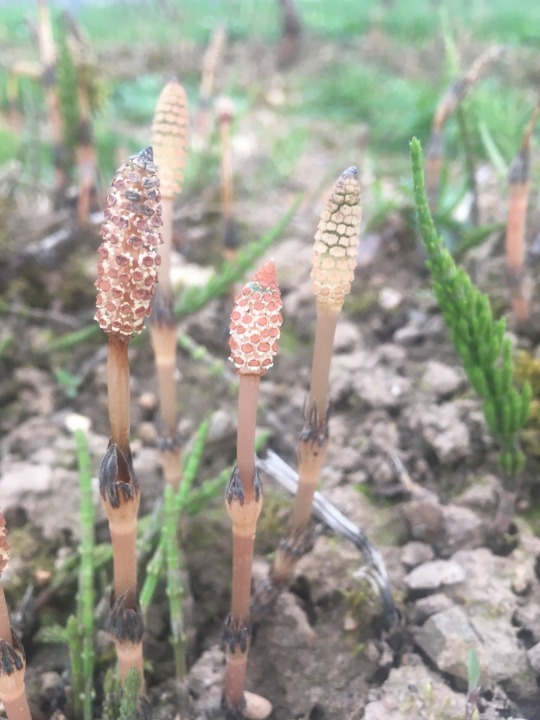
Equisetum arvense about to release spores :) These guys were already around when the dinosaurs still roamed the planet, and hopefully they'll stay till the very end. Resilient little creatures, always love seeing them pop up in spring.
0 notes
